Is ambergris whale vomit or whale poo? We find out in Naked Oceans this month as we dive into ocean treasures, old and new. Last month we explored some of the ways we pollute the oceans by using them as a dumping ground for too much rubbish. And in this episode we look at the variety of things we've taken out of the ocean, from prized perfumes to inspiration for new medicines. Christopher Kemp tells us all about the mysterious stuff, ambergris - the subject of his new book. And at Scripps Institute of Oceanography, we call in on some researchers who are putting glowing critters to good use. And in Critter of the Month, Emmett Duffy tell us, if he was a marine creature, which one he'd be and why.
In this episode
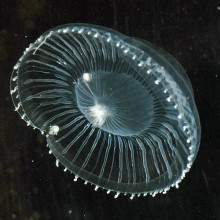
01:25 - Singing a song of GFP
Singing a song of GFP
with Professor Karmadillo
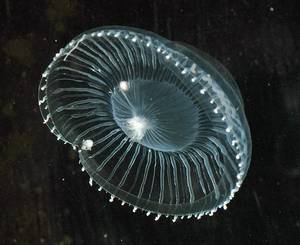 Green Fluorescent Protein, GFP, is an important research tool originally extracted from jellyfish. It's so important, it inspired science songwriting virtuoso Professor Karmadillo to write a song about it...
Green Fluorescent Protein, GFP, is an important research tool originally extracted from jellyfish. It's so important, it inspired science songwriting virtuoso Professor Karmadillo to write a song about it...
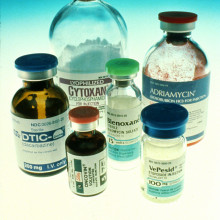
02:45 - Medicines from Marine Microbes
Medicines from Marine Microbes
with Paul Jensen, Scripps Institution of Oceanography; Marcel Jaspars, University of Aberdeen
Marine species from corals and sea squirts, right down to the tiniest bacteria, are offering up chemicals that could be potential new treatments for infectious diseases and cancer.
The 'secondary metabolites' produced by these species are used as defences against infection or to outcompete other microorganisms, and humans have been exploiting them for over 50 years.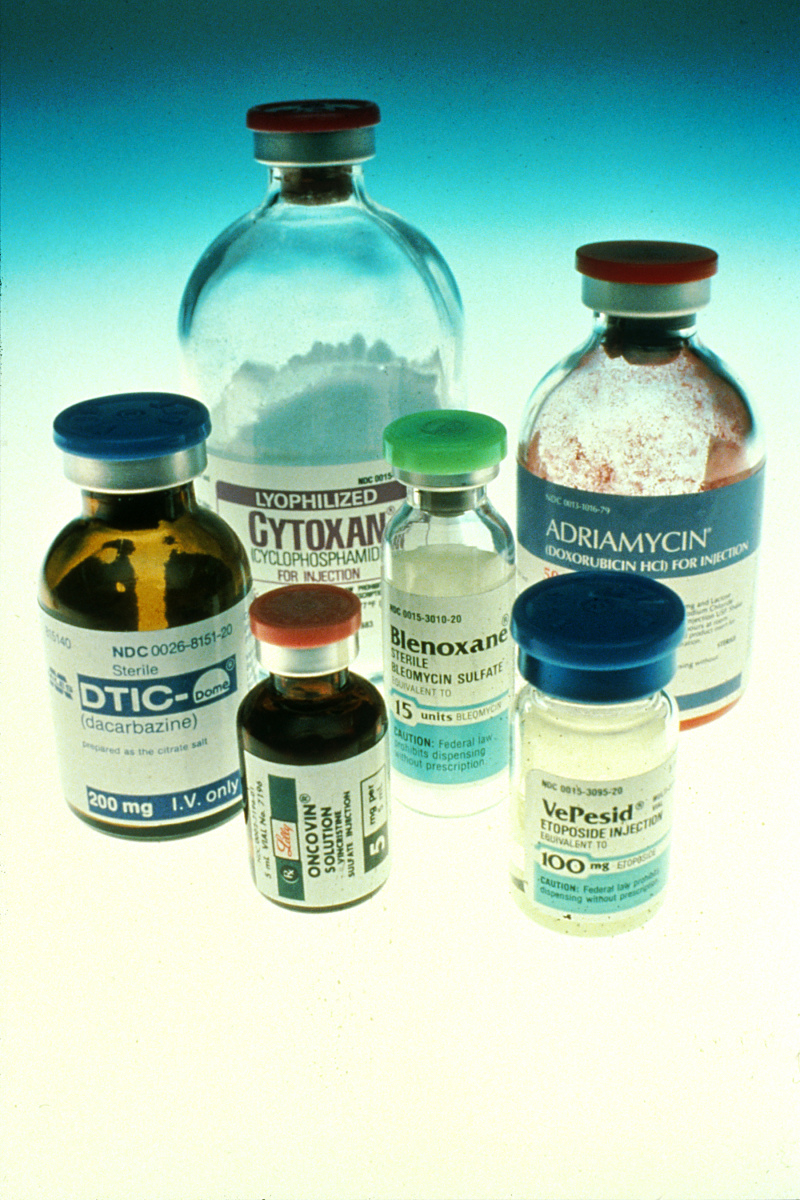
Paul Jensen from the Scripps Institution of Oceanography explains why his work on marine microbes has led to some interesting discoveries about the evolution of bacteria in the oceans, as well as new drugs, and Marcel Jaspars from the Marine Biodiscovery Centre at the University of Aberdeen explains how we go from seabed to bedside...
Sarah - Since the mid 20th century, scientists have been investigating marine species and the chemicals they produce, pointing towards new medicines, that can be used to fight diseases from cancer to sleeping sickness.
Paul - 50 years ago a group of organic chemists who were interested in marine science and interested in diving put those interests together and decided to start going to the ocean and collecting plants and animals and extracting them and studying organic compounds that they make. And that was really just a bonanza because pretty much everything that was picked up had new molecules in so it was the golden age of marine natural products chemistry.
Sarah - That was Paul Jensen, from the Scripps Institution of Oceanography, who studies marine bacteria, and whose work has led to the discovery of compounds now in trials for cancer treatment. Initially, much of the research into finding new molecules focussed on larger ocean species, but then a whole new avenue of research opened up...
Paul - As time went on there was the realization that most of the diversity in the ocean is actually microbial and noone had studies it yet in terms of looking at the chemicals and natural products that these microbes makes. And so that really ushered in the next wave of ocean exploration in terms of bioprospecting, if you want to call it that, but I will call it natural products research.
Sarah - So why do species, from bacteria to corals, actually produce these compounds?
Marcel - Initially the invertebrates, the sponges, soft corals and sea squirts are interesting because they have no other obvious other means of defense. So we're looking at them because they have a chemical defense system without an alternative immune system perhaps, and these compounds tend to be very active.
Sarah - That's Marcel Jaspers, from the University of Aberdeen, who runs the Marine Biodiscovery Centre, which actively looks for potentially medically useful chemicals produced by marine species. As we just heard, the larger species being investigated, the sponges and corals, possibly use the active chemicals they produce as a defence mechanism. But what about bacteria? Paul Jensen...
Paul - in some cases these molecules may be produced for defensive purposes. They may be to compete and defend a resource from other competing microbes but it can also be more complicated than that. They can be signalling molecules, there's a lot of chemical communication going on in the ocean.
In fact this is a really exciting forefront of the field right now because people are realizing right now that the language that microbes communicate in is chemistry. And understanding how and why they produce these molecules and that process of communication is really an exciting part of where all of this is going.
Sarah - So if marine organisms produce these compounds as defence against infections or to outcompete other microorganisms, it's a logical step to guess that they could be effective treatments for infectious diseases.
Another exciting, non-medical part of the research is that it's giving us clues to the evolution of bacteria in the oceans...
Paul - when we look at these organisms one of the most fundamental things that distinguishes what we think are different groups are these molecules that they make. And that's been a challenge in microbiology from the early days is that in the case of bacteria they don't really look like much, and in many cases its hard to distinguish them and so now we have genomics and we can sequence their genomes and that gives us a complete blueprint of who they are. That tells us everything that they're capable of doing.
And when we look at the genomic level and we compare groups that we think are different but closely related what we see is that it's mostly in terms of these molecules of chemicals that they're making. So we think that the ability of bacteria to produce these, what we call secondary metabolites, maybe fundamentally important in defining who they are.
Sarah - And it's this kind of research, finding out who the bacteria are phylogenetically, as well as why they produce these compounds, that is the focus of Paul's work. The potential medical benefits are for him, an exciting side effect.
But once you extract the chemicals that you think might have some kind of useful medical action, how do you decide what to test them against? It's very much down to the research interests of the lab involved, and any industry collaborators, but as Marcel Jaspers explains, it helps to narrow it down...
Marcel - so first of all you need to know what your best bets are. So in natural products the things that we look at mainly are cancer, inflammation, infectious diseases, and parasitic diseases. That's where they've been proven to work the best.
Most of the drugs that are coming forwards through the pipeline are for cancer. There's painkillers on the market from sea snails. So we are really thinking about how to get from seabed to bedside, as people sometimes say.
The answer is that there's really a lot of effort needed to go from the small scale, from the milligram quantities that we can isolate, to the kg scales that are needed for clinical trials.
Sarah - And it's been a very successful field. Several molecules extracted from microbes, sea squirts and sponges have already undergone successful trials against cancer. Each of the compounds works in a slightly different way - by stopping cells from dividing or disrupting the cell cycle or blood supply to the tumour.
But, as we heard from Marcel, the main challenge is one of scale - how do we produce enough of the compound to use in a clinical trial, and then what happens if it ends up being rolled out as a treatment to the public? Isolating the gene that codes for the compound you're interested in, and inserting that gene into bacteria that will then produce it en masse is one solution.
This is one benefit to looking in bacteria for these compounds in the first place. Another benefit comes from a conservation point of view, reducing the pressure on larger organisms that might be collected for this kind of research. But, we shouldn't forget about the conservation of the bacteria either...
Paul - a lot of people don't think about the conservation side of microbes. And so, there's a couple of points here. One, in the early days when people were going to and collecting macroorganisms there's some issues there from a conservation side, because if you find something it might come from a rare organism, and oftentimes these molecules are very complex and they're not easy to synthesize in the laboratory and so you have to go to nature to collect them.
So the idea of working with microbes is attractive because you can culture them, you don't have to go back to nature to get them over and over again. So it's a renewable resource. So that's very attractive.
But secondarily this point about what's the diversity that's out there now, and how is that diversity changing in response to the impacts that humans have on the environment. And without question it is changing. We don't know if that's good or bad from the perspective of natural product discovery but my hunch is that it'd be bad because most likely the way things are changing is we're going to see less diversity over time. So that's actually a very important consideration that's often not even discussed when people think about conservation and diversity issues.
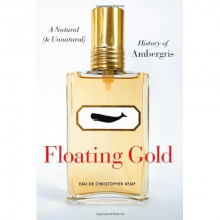
10:54 - Is ambergris whale vomit or whale poo?
Is ambergris whale vomit or whale poo?
with Christopher Kemp
Author Christopher Kemp tells us about the mysterious substance that people have prized for centuries...
Sarah - Ambergris comes from the guts of sperm whales and for centuries people have found lumps of it lying on beaches and invented all sorts of uses for it, most famously in fragrances. And there are still big mysteries surrounding this peculiar stuff.
Christopher Kemp is a molecular biologist who's spent the last couple of years on the trail of ambergris - and his book Floating Gold, has just been published by University of Chicago Press.
For a natural compound known for its use in perfumes, the surprising thing Christopher found out during his research was just how difficult it is to describe the smell of ambergris.
Christopher Throughout history people have really struggled to adequately describe the smell of ambergris. I actually have a couple of pieces right here as I speak to you and they're both very different to one another. I've got one piece that's black and fresh. It's even a little sticky in my hand and it smells like sheep dung. It's just incredibly dungy. It's what an organic chemist of a perfumer would call Indolic. It's got lots of indols and scatols in.
One of the more compelling things about it as a subject is that once it's been expelled in the ocean by a whale it requires years and years, perhaps even several decades of floating around in the ocean, being photo oxidised, being worked on by the seawater to mature into the really valuable expensive stuff.
So I'm holding now a piece of white ambergris and it smells completely different. It smells much sweeter, much more pleasant, it's just not as in your face as the fresh stuff.
Sarah - And while writing his book, Christopher fell under the spell of some pieces of extremely expensive ambergris...
Christopher - If you had somehow captured the smell of the ocean it would smell exactly like this one piece in particular that I'm thinking about. It was so ozoney, it was so full of that smell of wide open spaces and seaweed and marine life that it was almost like a scratch and sniff ocean sticker. It really caught me off guard. I was so taken by it I almost offered to buy it on the spot and it was probably worth about $1000 and I was not in a position to spend $1000 on a piece of aged whale poop. It was just such a smell I just really didn't want to stop smelling it.
Sarah - The main use of ambergris today is as a fixative in the perfume industry for which the genuine article is still extremely highly valued- it's not only the smell of ambergris itself that is prized, but its ability to make other aromas last for longer on the skin, due to its extremely low volatility.
In the past ambergris has been used for all sorts of things. It was used as a cooking ingredient and as late as the 18th century people were using it as a medicine, prescribing it to treat everything from headaches to impotence, bruises and even as an anti-depressant.
Christopher - The one use that I was really tickled by was that it used to be worn as jewelry as well. People would carve it and make ornate jewelry out of it and it was the heat from a woman's body would warm up the ambergris and make it smell more.
Sarah - And all the while they've been using it people have also been inventing a host of ideas about where this stuff comes from:
Christopher - There were explanations that it was a meteor that had fallen from outer space. Other people said that it was the liver of a certain species of fish. Because ambergris often appeared on the shore after storms or periods of stormy weather, there were quite a few theories that it grew on the ocean floor and was dislodged by stormy seas.
So people thought it was a special type of mushroom or a fungus that grew there or a fruit like a pear that grew in the ocean. People thought that it was the sperm of whales or that it was honey that had been cured by salt water.
When you think about it, the truth sounds just as ridiculous as all the other theories. So it's not a surprise that some of it sounds so strange.
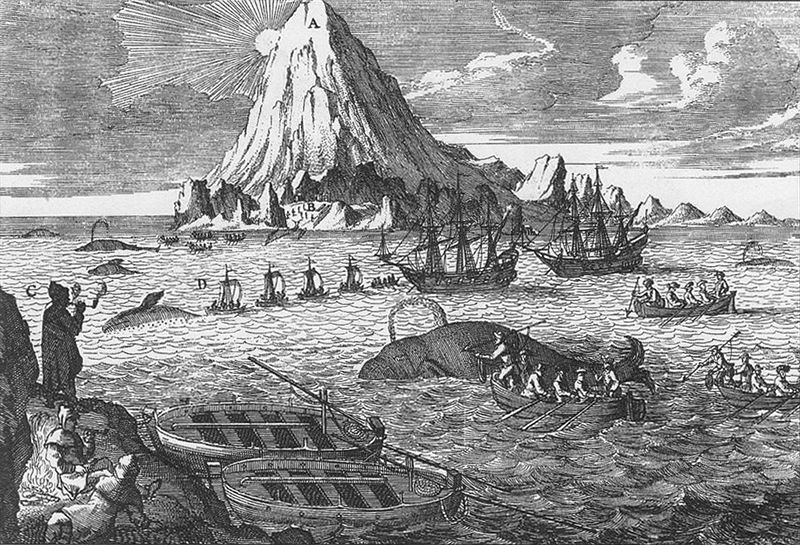
Sarah - The truth about the source of ambergris was only revealed with the development of the whaling industry. As people started killing more and more whales, it became clear that ambergris comes from inside sperm whales.
The most detailed analysis of how exactly ambergris forms was written by whale scientist, Robert Clark, who passed away last year. A bit like when seashells make pearls to deal with irritating bits of sand and grit, it seems that when the sharp, indigestible beaks of squid irritate a sperm whale's guts they trigger production of a cholesterol-rich secretion that binds the beaks together into a smooth, solid lump.
So, mystery solved! Perhaps... but still some confusion remains about which end that lump comes out - is ambergris whale vomit, or whale poo?
Christopher - If someone stumbles on a piece of ambergris somewhere you'll get some headline in the newspaper like "Whale coughs up a jackpot" or "Moby Sick makes man rich". And so there is still this confusion about whether its regurgitated or whether its expelled and pooped out. But you can talk about whether its just like a hairball, because that's another thing you come across time and again. But its not because hairballs don't smell like poop.
Sarah - The key component that's responsible for the unique nature of ambergris is a molecule called ambrein.

Christopher - It's the building block that gives rise to all the other aromatic compounds that are found in ambergris. And ironically its odourless. It's a very nondescript little molecular compound. It basically overtime in the ocean breaks down to produce this bouquet of other aromatic compounds that all smell of different things and that's why people smell these certain things like tobacco and mould and seawater.
So the journey is from ambrein to a substance called ambergris oxide, which is the one thing that smells exactly like ambergris, that doesn't smell like anything else and nothing else really smells like.
It's that ambergris oxide, or naptho-furan that chemists have copied to make synthetic ambergris, but as Christopher says, it's not really the same...
Christopher - It's like comparing an original Van Gogh to a print of Van Gogh. They certainly have the same molecular composition but there's something lacking. There's something that cannot be recreated in the lab.
Sarah - In his book, Christopher tells many stories of people finding objects washed up on a beach and believing they've found their fortune in a lump of ambergris - sometimes they're right but often they've been wrong. He spent a long time himself on a quest to find his own piece of valuable flotsam. So how do you know if you've found the genuine article? Well, it's not that straight forwards. We already know it can have various different smells, but it also comes in various shapes and colours:
Christopher - It can be anything from black like a little piece of coal, to white and pitted like a piece of pumice, and any colour in between really. And it just has to look like nothing else on the shoreline. That's the best way to try and find it. So basically it's a process of elimination, if you can say well that's definitely some rotting seaweed, or that's definitely a piece of driftwood or a dead seagull, then you know that's not ambergris but otherwise there's an enormous range of things that could be ambergris.
Sarah - To help narrow things down there are a couple of simple tests that can help identify ambergris.
Christopher - It's slightly less dense than water and so it floats on the surface but not quite on the surface. It's almost like an iceberg in that part of it would bob above the surface but most of it would be below. So you have to make sure that it floats a little bit. If it feels heavy like a stone then it's not ambergris. The other traditional test, even if you go back to 1720 and read articles that were written then this is the test they tell you to do then, it's the test now - the hot needle test. Where you heat up a needle or a safety pin or something like that until it's really hot. And then you take your suspected piece of ambergris and you poke it with the hot needle. If it's ambergris then it would melt into a chocolate brown liquid and give off a real aroma and there would be a little bit of smoke because it's highly flammable. And that's really traditionally the sure-fire way of making sure you've got ambergris.
But there are plenty of things that float in the ocean that would react like that to a hot needle and that's where people get into a lot of trouble.
These days, the things that are most often mistaken for ambergris are actually manmade products that were manufactured by some industrial process and have been dumped into the ocean either on purpose or by accident. And then floated there for decades until they're no longer really recognisable. So often people will find these really weird shapes that obviously were plastic or something like that and they melt really readily when you poke them with a hot needle.
And so that's something that used to be a great test maybe 2-300 years ago when there were fewer things that react the way that ambergris does but these days I think you could walk along almost any beach after a really violent storm and you could find things that have been manmade in some factory that melt into a chocolate brown liquid.
Find out more:
Floating Gold, Christopher Kemp, Chicago University Press
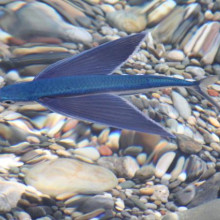
21:15 - Critter of the month - The Flying Fish
Critter of the month - The Flying Fish
with Emmett Duffy, Virginia Institute of Marine Science
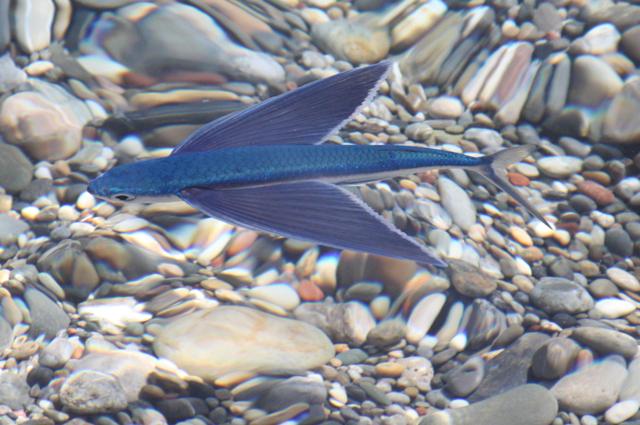 We ask Emmett Duffy from the Virginia Institute of Marine Science, if he was a marine creature, which one would be be and why? His answer - the elegant flying fish.
We ask Emmett Duffy from the Virginia Institute of Marine Science, if he was a marine creature, which one would be be and why? His answer - the elegant flying fish.
Emmett - My name is Emmet Duffy. I'm marine ecologist at the Virginia Institute of Marine Sciences in the USA. Being a marine biologist that's a really tough one to answer because there's so many amazing creatures in the ocean. But I think if I had to pick one it would be the flying fish, although I prefer its much more elegant name in Spanish which is Pez volador.
I love the flying fish because they remind me of the tropical ocean, of being out on the open turquoise blue water and just seeing them skittering across the horizon is such a wonderful thing.
And also I identify with them because they're amphibious. They're partially at home outside the water and also at home inside the water which is what I aspire to be as a diver and marine biologist.









Comments
Add a comment